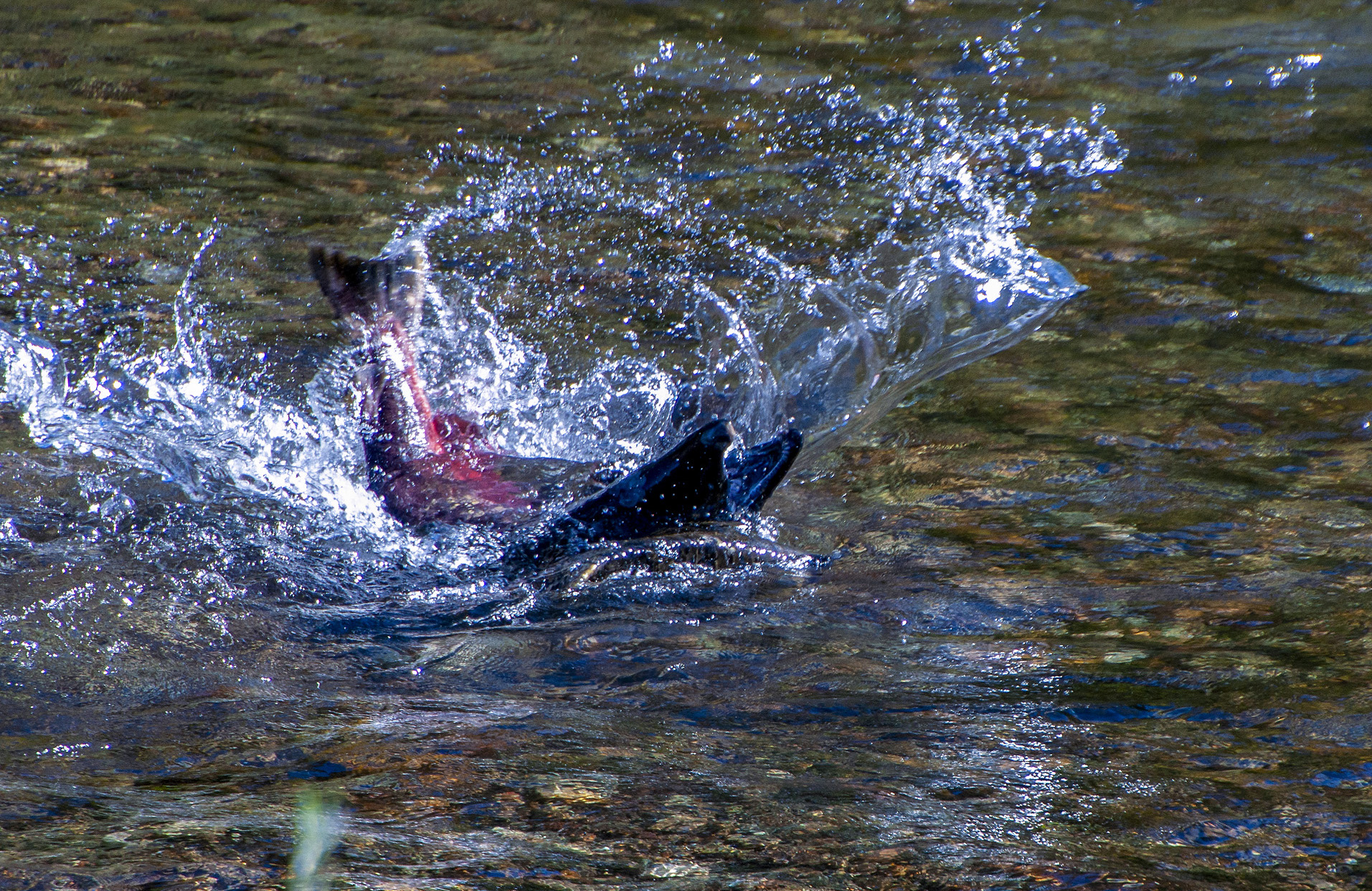Grow fast, die young: is climate change making fish age faster?
“Humans and other endothermic, or “warm-blooded” animals have the luxury of a built-in temperature control system. For ectothermic animals like amphibians, reptiles, and fish, maintaining body temperature isn’t as easy – especially in the face of climate change. “Cold-blooded” animals can modify their temperature through behavior, such as basking in the sun or hiding in the shade, but are more vulnerable to fluctuating temperatures than their warm-blooded cousins. With global temperatures predicted to increase by up to 4˚C by 2100, accompanied by more frequent heat waves, climate change may outstrip the coping mechanisms of ectotherms, with potential negative impacts on their physiology and fitness. … ” Read more from FishBio here: Grow fast, die young: is climate change making fish age faster?
Restoring Dry Creek: Joint project with U.S. Air Force opens spawning habitat for threatened steelhead
“In 1943 the Army completed a dam on Camp Beale so its soldiers could fish, swim and jump off the dam’s diving platform. Nearly 80 years later, the Air Force is giving Dry Creek back to the original tenants: its fish. “The dam was built to provide recreation,” said Paul Cadrett, a fish biologist and habitat restoration coordinator for the U.S. Fish and Wildlife Service in Lodi, California. “Then in the ’80s someone said, ‘Hey, there are fish banging their heads at the bottom of this dam,’ so they built a fish ladder. But it didn’t work very well, and most fish weren’t able to navigate it.” … ” Read more from the USFWS here: Restoring Dry Creek: Joint project with U.S. Air Force opens spawning habitat for threatened steelhead
Restoration brings salmon, people back to Clear Creek
“Clear Creek has been transformed multiple times in the past two centuries, but the transformation of the past few decades was designed to last. Ravaged first by gold-seekers and then by gravel-miners, the Sacramento River tributary is today a haven for fish and people alike. “You get to see big male salmon chasing each other away from females and see females digging redds, or nests. It’s exciting,” said U.S. Fish and Wildlife Service biologist Charlie Chamberlain. “It’s something a lot of people would not expect to see in California except on National Geographic.” … ” Read more from the US FWS here: Restoration brings salmon, people back to Clear Creek
Grazing and riparian restoration are compatible when you put in the work
“With a little time and effort, rangeland managers can have a dramatic impact on the resilience of California’s riparian areas, which are important to the state’s human, environmental and economic well-being. Rangeland ecologists at the University of California, Davis, found that when ranchers invest even one week a year in practices that keep cows away from creeks — like herding, fencing and providing supplemental nutrition and water — they can improve riparian health by as much as 53 percent. … ” Read more from UC Davis here: Grazing and riparian restoration are compatible when you put in the work
Researchers quantify carbon changes in Sierra Nevada meadow soils
“Meadows in the Sierra Nevada mountains are critical components of watersheds. In addition to supplying water to over 25 million people in California and Nevada, meadows contain large quantities of carbon belowground. While it has been known for some time that meadows have large quantities of soil carbon, whether meadow soils are gaining or losing carbon has remained unclear. A new study led by researchers in the College of Agriculture, Biotechnology & Natural Resources at the University of Nevada, Reno, has demonstrated for the first time that meadows throughout the region are both gaining and losing carbon at high rates. … ” Read more from Science Daily here: Researchers quantify carbon changes in Sierra Nevada meadow soils
Higher atmospheric thirst from climate change to increase fire danger and drought in California and Nevada
“Since the start of the 21st century California and Nevada have suffered extreme wildland fires and droughts that have caused devastating impacts to ecosystems and society. A common feature of these events has been very high evaporative demand—the “thirst” of the atmosphere—which has largely been driven by increased air temperatures caused by anthropogenic climate change. New research, funded by the National Integrated Drought Information System and the California-Nevada Applications Program (CNAP), a CPO RISA team, shows that climate change projections point to increases in evaporative demand, fire danger and drought in California and Nevada. … ” Read more from the Climate Program Office here: Higher atmospheric thirst from climate change to increase fire danger and drought in California and Nevada
Different models, different answers in water resource planning
“Effective management of water resources depends on accurately predicting future water supplies and demands that regularly fluctuate because of population growth, climate change, and many other factors. To deal with large uncertainties in these considerations, water resource planners often use what is known as a scenario-neutral approach in their projections. In contrast to scenario-driven methods, which assess the potential effects of specific, model-derived conditions, a scenario-neutral approach uses sensitivity analysis to determine which input factors, such as seasonal precipitation and population growth, most affect performance. … Now Quinn et al. question whether this approach is truly scenario neutral. … ” Read more from EOS here: Different models, different answers in water resource planning
Plastic pollution is everywhere. Study reveals how it travels
“Plastic pollution is ubiquitous today, with microplastic particles from disposable goods found in natural environments throughout the globe, including Antarctica. But how those particles move through and accumulate in the environment is poorly understood. Now a Princeton University study has revealed the mechanism by which microplastics, like Styrofoam, and particulate pollutants are carried long distances through soil and other porous media, with implications for preventing the spread and accumulation of contaminants in food and water sources. … ” Read more from Science Daily here: Plastic pollution is everywhere. Study reveals how it travels
SCIENCE IN SHORT: Wall-to-Wall Sampling Via Remote Sensing
Invasive plants – the submerged and floating kind – clog nearly a third of the Delta’s waterways today. These alien weeds invite native fish predators to hide in their murky jungles, fuel algal blooms, rearrange the ecosystem, and prevent boats from passing through. But Cal Fish & Wildlife senior scientist Shruti Khanna is keeping an eye on the spread of these Delta weeds from above. In this new Science in Short podcast, Khanna explains how large images captured by remote sensors mounted on satellites, planes, and drones afford wall-to-wall sampling of the Delta.
About Science News and Reports: This weekly feature, posted every Thursday, is a collection of the latest scientific research and reports with a focus on relevant issues to the Delta and to California water, although other issues such as climate change are sometimes included. Do you have an item to be included here? Submissions of relevant research and other materials is welcome. Email Maven




